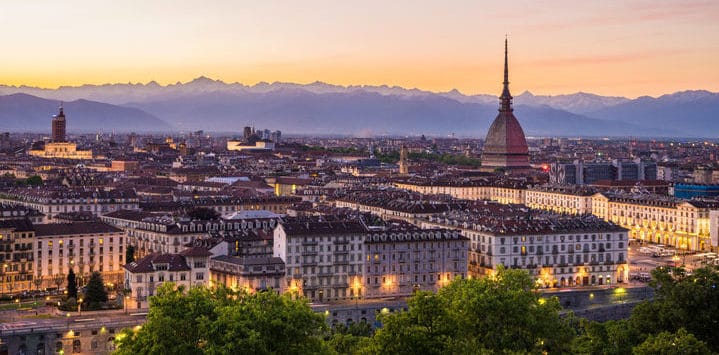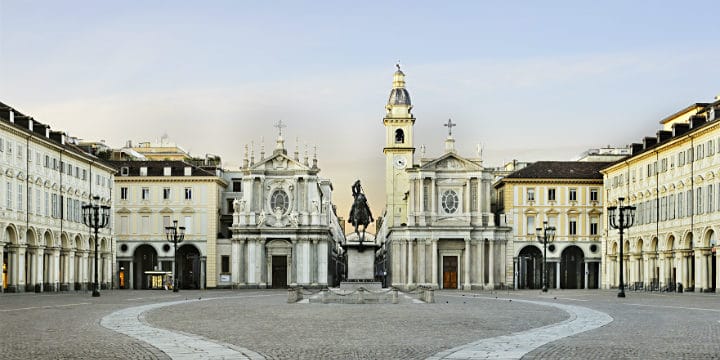
Gay Turin · City Guide
First time travelling to Turin? Then our gay Turin city guide is for you.

Turin | Torino
The capital city of the Piedmont region. Turin is one of North Italy's most important cities. It is home to around 900,000 people but over 2 million people live within its metropolitan area.
Beginning life as a Roman military fort, Turin became the capital city of the House of Savoy in the 13th Century. From 1861-65, it became the first capital of a unified Italy. In 1902, the Universal Exposition was held here and it led to the popularity of the Art Nouveau movement. It was bombed heavily by the allies during World War II.
Post-war, the car industry exploded in Turin and Fiat, amongst other famous car brands, is still headquartered here. It has been ranked as the 78th richest city in the world by purchasing power, and it is one of Italy's centres of education. Tourists are attracted to its dazzling architecture, great restaurants and shopping opportunities.
Gay Rights in Italy
For information about gay rights in Italy, please visit our Gay Rome City Guide page.
Gay Scene in Turin
Italy's first gay rights group, Fiori, started in Turin in 1971, so it's no surprise that the city is very welcoming of the LGBT community. Whilst the gay scene is not huge, there are a handful number of gay venues including two Gay Saunas, a Gay Bar and several gay-popular events.
Turin hosts its annual gay Pride parade in June which is one of the biggest gay events in Northern Italy. The Gay & Lesbian Film Festival (originally called 'From Sodom to Hollywood') in April is another popular event held in Turin.
Getting to Turin
By plane
Turin Airport/Turin-Caselle Airport/Sandro Pertini Airport (TRN) is located 16km north west from the centre of Turin in the town of Caselle. It is well served to destinations in Europe, the Middle East and North Africa where you can get long-haul connections to destinations further away.
From the airport you can take a train to Dora Station from the hours of 5am-9pm (weekdays). The journey takes 19 minutes and from here you can take a bus into the city centre. The Dora Express service is quicker than other buses (15 minutes) and runs from around 7am-8pm (Monday-Saturday). An integrated ticket costs €3.
You can also take a direct route into Turin's city centre. The journey takes 45-50 minutes (traffic dependent) and leaves from the arrival area where there is a ticket office and machine. A single journey costs €6.50 with an extra €1 added to the cost if bought from the driver.
A taxi rank can be found at the arrivals level. A journey will cost you in the region of €30-50 so it may be worthwhile seeing if your hotel offers a free transfer or if you can pre-order at a cheaper rate. Major car hire companies have offices in the arrivals lounge and car park. The drive into the city takes around 30 minutes.
By train
There are three main railway stations in Turin. Porta Nuovais a modern station where you will travel to/from if coming from the north of Italy and destinations towards Paris. Porto Susa and Lingotta FS stations are your entry point if coming from the south.
 main view of San Carlo square
main view of San Carlo square
Getting around Turin
On foot
The centre of Turin is easy to navigate on foot - a good way to take in the city's almost Parisian boulevards. You will only really need to take public transport if travelling further afield, in bad weather or if loaded with shopping.
By public transport
GTT operates Turin's integrated public transport network of buses, trams and metro system. Tickets must be bought in advance before travel and validated as soon as the journey begins. Prices start at €1.70 for a 90 minute journey but it is worthwhile getting a 3-day Torino and Piemonte card (€29) as it offers free entry to Turin's top sights.
Most services run from 5am until midnight with some night bus services operating through the night. Ticket inspectors are common and have a reputation for being rude. Blue buses are for suburban routes and can be more expensive than if travelling within Turin's urban area.
By taxi
There are taxi ranks throughout Turin but note it is not customary to hail taxis on the street. It is also worth noting that if you pre-order a taxi, the meter starts running from the moment the taxi receives your call. Taxi apps such as Uber are available here.
Where to Stay in Turin
For a list of some of the best hotels in Turin, please click on the Turin Hotels page.
Things to See & Do in Turin
Mole Antonelliana - the most iconic building in Turin. Originally constructed as a synagogue in 1888, the Mole Antonelliana is home to a fantastic cinema museum, and you can take an elevator to the top of its tower.
The Cathedral of Saint John the Baptist - while this cathedral is certainly attractive in its own right, its main draw is the Shroud of Turin. Unfortunately, it is not always on display and is only exhibited to the public by papal decree.
8 Gallery and Eataly - a long gallery with many shops. Here you can sample some of the world's best Italian food and great examples of the Slow Food Movement of which Turin is famous for.
Porta Palazzo Market - one of the largest markets in Europe. Here you will find a diverse collection of second hand goods and artisan products and is an amazing spectacle to take in.
La Venaria Reale - this beautifully restored 17th Century palace is a dazzling example of Baroque architecture. Situated 10 km north east of Turin, this is one of Italy's most popular tourist attractions.
Museo dell'Automobile - not just for the car lovers. Here you can find out about Turin's heritage as Italy's auto-manufacturing centre but also check out some pretty sexy sports cars.
Valentino Park - Turin's largest park and situated alongside the River Po. A perfect place for a picnic and also the location of the Valentino Castle and Medieval Village.
Egyptian Museum - here you will find one of the best collections of Egyptian artefacts this side of the Nile. The exhibits are very well preserved and the museum is well signposted. Closed on Mondays.
When to Visit Turin
Due to its northerly latitude, Turin is quite cold in the winters but the Alps act as a buffer from the rain. Snow is surprisingly common in April but Summers are hot, and you can expect the odd thunderstorm. The busiest months for tourists are July, May and February so it may be worthwhile trying to avoid these months (if possible).
There are a variety of festivals and events of interest to visitors. The Torino Film Festival, held in the city's cinema museum, is the second largest film festival in Italy. Kappa FuturFest (KFF) hosts an incredible line-up of international and local DJ's in July.
Visa
Italy is a member of the European Union and as such, its visa falls inline with what you'd expect from other European countries. It is also a member of the Schengen Zone. Please check with the Italian foreign office's website if you have any visa queries.
Money
Italy is a member of the euro zone. ATM’s (known in Italy as’ bancomat’) are widely available, and most will accept Visa and MasterCards. You can exchange your money in banks, at post offices or at a ‘cambio’ (exchange office).
Join the Travel Gay Newsletter
Have we got something wrong?
Are we missing a new venue or has a business closed? Or has something changed and we have not yet updated our pages? Please use this form to let us know. We really appreciate your feedback.